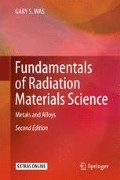Abstract
In our discussion of cascade development, no consideration was given to the spatial arrangement of displaced atoms. We assumed that every Frenkel pair created was preserved and that no annihilation occurred. However, the spatial arrangement of these Frenkel pairs is crucial in determining the number that survive annihilation or immobilization by clustering. In order to understand what the damaged region looks like, we need to know whether the displacements are concentrated or distributed. A helpful tool in this regard is the mean free path for displacement collisions, i.e., collisions in which the energy transferred is greater than E d. This will tell us how far apart the displacements occur and hence the separation distance between Frenkel pairs.
Additional material to this chapter can be downloaded from http://rmsbook2ed.engin.umich.edu/movies/
Access this chapter
Tax calculation will be finalised at checkout
Purchases are for personal use only
References
Olander DR (1976) Fundamental aspects of nuclear reactor fuel elements, TID-26711-P1. Technical Information Service, Springfield
Averback RS (1994) J Nucl Mater 216:49
Brinkman JA (1956) Amer J Phys 24:251
Seeger A (1958) On the theory of radiation damage and radiation hardening. In: Proceedings of the Second United Nations international conference on the peaceful uses of atomic energy, Geneva, vol. 6. United Nations, New York, p 250
Nastasi M, Mayer JW, Hirvonen JK (1996) Ion-solid interactions: fundamentals and applications. Cambridge University Press, Cambridge
Was GS, Allen TR (1994) Mater Charact 32:239
Sigmund P (1981) Sputtering by ion bombardment: theoretical concepts. In: Behrisch R (ed) Sputtering by particle bombardment, Springer, Berlin, p 9
Heinisch HL (1996) J Metals, Dec:38
Robinson MT (1994) J Nucl Mater 216:1
Robinson MT, Torrens IM (1974) Phys Rev B 9:5008
Beeler JR (1966) Phys Rev 150:470
Ziegler JF, Biersack JP, Ziegler MD (2008) SRIM—The Stopping Range of Ions in Matter, Ion Implantation Press (http://www.srim.org)
Cai W, Li J, Yip S (2012) Molecular Dynamics in Konings RJM (ed.) Comprehensive nuclear materials, 1.09:249. Elsevier, Amsterdam
Finnis MW, Sinclair JE (1984) Phil Mag A50:45–55; (1986) Erratum Phil Mag A53:161
Calder AF, Bacon DJ (1993) J Nucl Mater 207:25–45
Stoller RE (2012) Primary radiation damage formation. In: Konings RJM (ed) Comprehensive nuclear materials, 1.11:293. Elsevier, Amsterdam
Becquart CS, Wirth BD (2012) Molecular dynamics. in Konings RJM (ed) Comprehensive nuclear materials, 1.14:393. Elsevier, Amsterdam
Dalla Torre, J, Bocquet, J-L, Doan NV, Adam E, Barbu A (2005) Phil Mag 85:549
Lanore JM (1974) Rad Eff 22:153
Caturla MJ, Soneda N, Alonso E, Wirth BD, Diaz de la Rubia T, Perlado JM (2000) J Nucl Mater 276:13
Domain C, Becquart CS, Malerba L (2004) J Nucl Mater 335:121
Heinisch HL, Singh BN, Golubov SI (2000) J Nucl Mater 276:59
Souidi A, Becquart CS, Domain C et al (2006) J Nucl Mater 355:89
Arevalo C, Caturla MJ, Perlado JM (2007) J Nucl Mater 362:293
Heinisch HL, Trinkaus H, Singh BN (2007) J Nucl Mater 367–370:332
Malerba L, Becquart CS, Domain C (2007) J Nucl Mater 360:159
Diaz de la Rubia T, Averback RS, Benedek R, King WE (1987) Phys Rev Lett 59(19):1930
Zinkle SJ, Singh BN (1993) J Nucl Mater 199:173
Naundorf V (1991) J Nucl Mater 182:254
Was GS, Allen TR (2007) Radiation effects in solids. In: Sickafus KE, Kotomin EA, Uberoage BP (eds) NATO science series, vol 235. Springer, Berlin, pp 65–98
Rehn LE, Okamoto PR, Averback RS (1984) Phys Rev B 30(6):3073
Iwase A, Rehn LE, Baldo PM, Funk L (1996) J Nucl Mater 238:224–236
Bacon DJ, Gao F, Osetsky YN (2000) J Nucl Mater 276:1–12
Deng HF, Bacon DJ (1996) Phys Rev B 54:11376
Calder AF, Bacon DJ (1997) In: Proceedings of symposium on microstructure evolution during irradiation, vol 439. Materials Research Society, Pittsburgh, PA, p 521
Stoller RE, Guiriec SC (2004) J Nucl Mater 329–333:1228
Author information
Authors and Affiliations
Corresponding author
Rights and permissions
Copyright information
© 2017 Springer Science+Business Media New York
About this chapter
Cite this chapter
Was, G.S. (2017). The Damage Cascade. In: Fundamentals of Radiation Materials Science. Springer, New York, NY. https://doi.org/10.1007/978-1-4939-3438-6_3
Download citation
DOI: https://doi.org/10.1007/978-1-4939-3438-6_3
Published:
Publisher Name: Springer, New York, NY
Print ISBN: 978-1-4939-3436-2
Online ISBN: 978-1-4939-3438-6
eBook Packages: EngineeringEngineering (R0)

